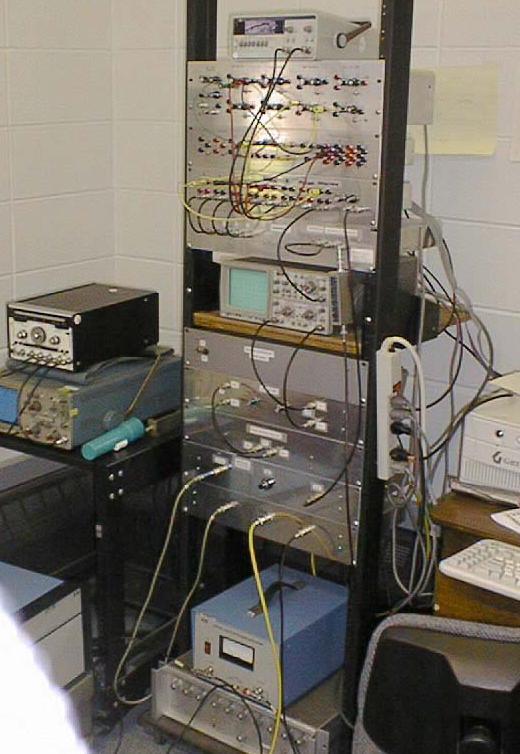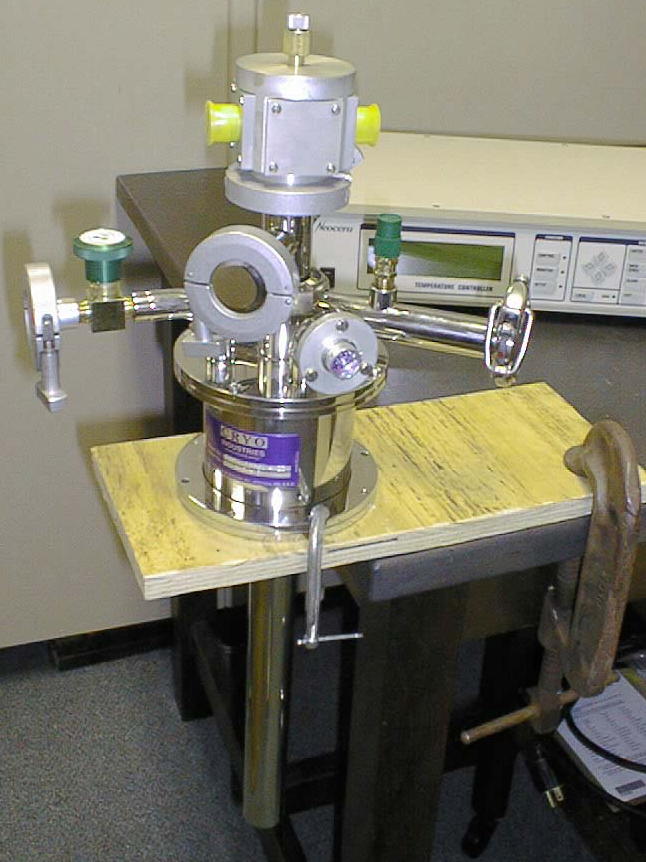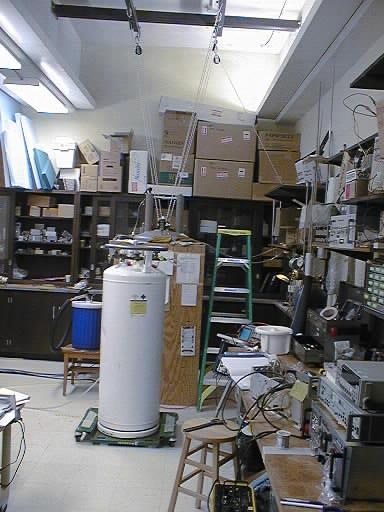| Introduction | Facilities | Publications | Presentations | Alumni |
|
|
In the Nuclear Magnetic
Resonance (NMR) lab, Professors Adolphi and McDowell work with students
on a wide range of solid state physics problems. Primarily,
we study the structure and dynamics of solids containing hydrogen, although
we are also interested in other elements, as well as more theoretical questions
that arise in the course of our experimental work.
Typically, we have two to four students working in the lab during the summers. These students are paid from research grants, on-campus fellowships, or other on-campus moneys. During the academic year, some students have pursued research for academic credit, utilizing the Independent Study course option. To prepare for work in the NMR lab, students can take Physics 241:Techniques of Experimental Physics and Physics 201:Nuclear Magnetic Resonance, although neither course is required. We frequently have students start in the lab after their first year of physics courses; these students often come back for a second or third summer. Talk to the professors if you are interested. Currently, the lab
is funded via grants from the National Science Foundation and the Research
Corporation (both with matching funds from Knox College) for work on hydrogen
in quasicrystals. Other projects of current interest include studies
of the structure underlying the metal-insulator transition in "switchable
mirror compounds," the theoretical question of how disorder in a material
will affect NMR linenarrowing, and the source of the two-time-scale dynamics
of hydrogen molecules absorbed in solid C60.
|
|||||
 |
 |
|
| There are two NMR labs in the Physics Department at Knox. The upstairs lab, built around a 2 Tesla electromagnet, is optimized for the study of dynamics in solids. The electromagnet allows the easy variation of field strength and therefore NMR frequency, which in turn probes motions occurring at different timescales. Typically, we measure the relaxation rates of 1H in our samples, accomplished by the homebuilt spectrometer shown above together with the data acquisition computer running our own experiment control software. Temperature is a crucial variable for dynamics studies, and we do most of our work using a continuous-flow cryostat, shown in the middle picture. In the right hand picture, you see the 60 liter helium storage tank and transfer line of the variable temperature system. Also in the right hand picture you see the most crucial part of the experiment, in this case, Tom Danielson. | ||
 |
The downstairs lab is built around a superconducting magnet
and is usually used for Magic Angle Spinning experiments. The
magnet runs in persistent mode, so the magnetic field maintains a fixed
value. In the upper picture, the magnet is protected by a plywood
box to keep any ferromagnetic items well away from the magnet bore.
The large white tank is filled with liquid nitrogen. Liquid nitrogen
is used for three purposes in this lab: to help keep the superconducting
magnet cold, to provide clean nitrogen gas for the MAS system, and to allow
the sample to be cooled. (The MAS probe is outfitted with a variable
temperature facility. ) To the right in the upper picture, one sees
the electronics construction and testing benches.
The lower picture shows the end of the MAS probe itself. Visible are the blue lines for the bearing and drive gas, and the low pressure black hose bringing in the purge gas. The probe is down, out of the magnet bore. When running, the probe spins the sample at speeds up to 10 kHz or more. That's 600,000 RPM! At these speeds the forces at the outer edge of the 5mm diameter rotor are immense. |
N.L. Adolphi, S. Badola, L.A. Browder, R.C. Bowman, Jr., “Magic-Angle Spinning NMR Study of Deuterium Site Occupancy and Dynamics in ZrNiD1.0 and ZrNiD3.0,” submitted to Phys. Rev. B, July 2001.
A. F. McDowell, Natalie L. Adolphi, C.A. Sholl, “Site and barrier energy distributions that govern the rate of hydrogen motion in quasicrystalline Ti45Zr38Ni17Hx,” submitted to Journal of Physics: Condensed Matter June 2001.N. A. Stojanovich, D.W. Pfitsch, A. F. McDowell, Natalie L. Adolphi, E.H. Mazjoub, J.Y. Kim, and K. F. Kelton, “Conduction-electron-mediated 1H nuclear spin-lattice relaxation in Ti45Zr38Ni17Hx icosahedral quasicrystals,” Philosophical Magazine Letters, 80, 763 (2000).
K.R.Faust, D.W. Pfitsch, N.A. Stojanovich, A.F. McDowell, N.L. Adolphi, Eric Majzoub, J.Y. Kim, P.C. Gibbons, and Ken Kelton, “NMR second-moment study of hydrogen sites in icosahedral Ti45Zr38Ni17 quasicrystals,” Phys. Rev. B. 62, 11444 (2000).
D.W. Pfitsch, A.F. McDowell, and Mark S. Conradi, “What are the conditions for exponential time-cubed echo decays?” J. Magn. Reson. B. 139, 364 (1999).
Lisa Browder, "Nuclear Magnetic Resonance Spectroscopy of Deuterium in Crystalline Zr-Ni," The McNair Journal of Multidisciplinary Research (Knox College, Summer 1999)
A.F. McDowell, Peter A. Fedders, Mark S. Conradi, “Spin relaxation for motion restricted to two dimensions,” Phys. Rev. B 58, 248 (1998).
J.J. Balbach, M.S. Conradi, M.M. Hoffmann, T.J. Udovic, and N.L. Adolphi, “Nuclear Magnetic Resonance Evidence of Disorder and Motion in Yttrium Trideuteride,” Phys. Rev. B 58, 14823 (1998).
“Conduction-electron-mediated 1H nuclear spin-lattice relaxation in Ti45Zr38Ni17Hx icosahedral quasicrystals,” (Poster) Hydrogen-Metal Systems Gordon Research Conference, New London, CT, July 2001. (McDowell)
“Deuterium site occupancy and motion in ZrNiDx by high-resolution 2H NMR spectroscopy” (Poster) Hydrogen-Metal Systems Gordon Research Conference, New London, CT, July 2001. (Adolphi)
“2H NMR Reveals Two Distinct Deuterium Populations at Room Temperature in LaD2.99,” (Poster) Hydrogen-Metal Systems Gordon Research Conference, New London, CT, July 2001. (Adolphi)“Simultaneous characterization by NMR relaxation measurements of site and barrier distributions for interstitial motion,” APS March Meeting, Seattle, WA, 12-16 March 2001. (McDowell)
“Deuterium Site Occupancy and Motion in ZrNiDx by High-Resolution 2H NMR Spectroscopy,” APS March Meeting, Seattle, 12-16 March 2001. (Adolphi)“Conduction-electron-mediated 1H nuclear spin-lattice relaxation in Ti45Zr38Ni17Hx icosahedral quasicrystals,” APS March Meeting, Seattle, WA, 12-16 March 2001. (McDowell)
“Quasicrystals: New NMR experiments for studying them,” (McDowell)
Physics Seminar, Kenyon College, 22 January 2001.
Physics Colloquium, Union College, 12 February 2001.“Relaxation due to motion in disordered systems: a new analysis method,” Chicago Area NMR Discussion Group, University of Illinois, 28 October 2000. (McDowell)
Lisa Browder, "Study of LaD3.0 switchable Mirror Compound using 2D Magic-Angle-Spinning Nuclear Magnetic Resonance Spectroscopy," McNair Conference, Penn State U., August 2000.
“High-Resolution NMR Spectroscopy of Crystalline and Quasicrystalline Metal-Deuterides,” Condensed Matter Seminar, Physics Department, Washington University, St. Louis, MO, February 2000. (Adolphi)“New NMR methods for studying metal hydrides: Batteries, refrigerators, and quasicrystals,” Condensed Matter Seminar, University of Minnesota, 28 October 1999 (McDowell)
Sherry Badola, "Deuterium NMR Spectroscopy of ZrNiDx" (Poster) Illinois State Academy of Science Meeting, Springfield, IL, April 1999.
Lisa Browder, "Nuclear Magnetic Resonance Spectroscopy of Deuterium in Crystalline Zr-Ni,"
McNair Conference, Penn State U., August 1999
Pew Undergraduate Research Symposium, U. of Chicago, November 1999“Looking at Quasicrystals Through Magic Eyes” Physics Seminar, Oberlin College, 21 April 1999 (McDowell)
“NMR Spectroscopy of Deuterium in Crystalline ZrNi,” (Poster) Hydrogen-Metal Systems Gordon Research Conference, Henniker, NH, July 1999. (Adolphi)
“NMR studies of Quasicrystals,” (Invited talk) Hydrogen-Metal Systems Gordon Research Conference, Henniker, NH, 18-23 July 1999 (McDowell)
“Tau-cubed echo decays,” (Poster) Magnetic Resonance Gordon Research Conference, 27 June - 2 July 1999 Henniker, NH (McDowell)
Kristen Faust, Woody Pfistch
Pew Undergraduate Research Symposium, 13-15 November 1998Nick Stojanovich
American Association of Physics Teachers, Illinois Section, 24-25 April 1998, Knox College“Where are the D atoms in YD2 and YD3?” (Invited talk) Hydrogen-Metal Systems Gordon Research Conference, Henniker, NH, July 1997. (Adolphi)
“Relaxation due to 2-D motion,” Poster presentation at the Gordon Research Conference on Magnetic Resonance 22-27 June 1997, Henniker, NH (McDowell)
Andy King, Morgan Sherman
Pew Undergraduate Research Symposium, November 1996, Washington University, St. Louis
Lisa Browder, technician intern at Argonne National Labs
Woody Pfitsch, finished the 3-2 engineering program at Columbia University
Paulo Priondi, in 3-2 engineering program at Washington University in St. Louis
Cameron Pizor, programmer for Caterpillar
Serhan Altunata, grad student in Physical Chemistry at MIT
Nick Stojanovich, in Navy Nuclear Engineering Program
Kristen Faust, Pew, financial services consulting?
Sherry Badola, programming
Morgan Sherman, math grad student at ???
Andy King, grad student in Physics at Washington University in St. Louis
Eric Anderson, working in Minneapolis
| Introduction | Facilities | Publications | Presentations | Alumni |